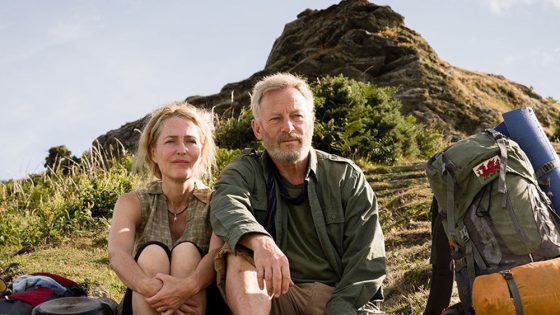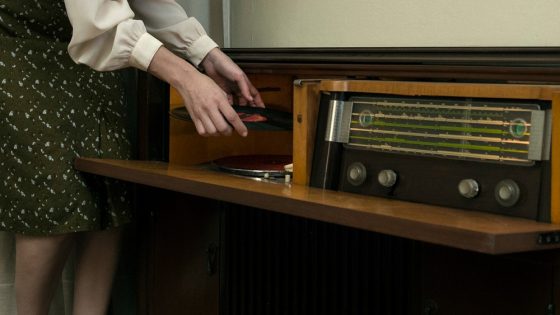From the very first moments of the “The Salt Path,” frantically capturing the vestiges of one middle-aged couple’s life swept out to sea by a turbulent tide of saltwater and sorrow, director Marianne Elliott’s inspirational drama chooses a deliberately deceptive path and gets off on the wrong foot. It’s not until later that it’s discovered that this in-media-res attention grabber, which has shaded our view of these downtrodden souls’ transformative journey, is a distorted reality. It’s used to manipulate us into anticipating that their watershed moment will be dire, when it’s really their saving grace. Yet with understated performances from Gillian Anderson and Jason Isaacs, as well as immersive land and soundscapes that enhance the thematic pull, this portrait of loss, humanity and rebirth makes it worth the emotional investment.
Fifty-somethings Ray Winn (Anderson) and her husband Moth (Isaacs) are having a rough go in their next stage in life. Turning their English countryside farmhouse into a quaint bed-and-breakfast isn’t bringing in a steady clientele. In addition to suffering financially from a shady investment deal and fighting a losing, years-long court battle, Moth’s been dealt a devastating diagnosis of Corticobasal syndrome – a degenerative, terminal neurological disorder with no cure. On top of all those troubles, they’re also dealing with empty nester loneliness, sending their kids Rowan (Rebecca Ineson) and Tom (Tucker St. Ivany) off to university, and have been court-ordered to vacate the only home they’ve known as a family.
On the day of their eviction, in a heartbreaking scene with bailiffs at their door banging and shouting as the homeowners shelter in their basement, Ray spontaneously formulates a plan: go for a walk. A long one. With a tent, limited supplies, very few clothes and the travelogue that inspired this trek, Raynor and Moth embark from Somerset on a quest to walk the 630-mile South West Coast Path. The amateur hikers make a few uneducated faux pas on the rugged trail, from not knowing how to negotiate gates when wearing stuffed backpacks to pitching their tent in high traffic areas where residents accost them, bellyaching about their presence. Inclement weather and jagged terrain also pose problems. But despite the harsh elements and the blisters and bruises on their bodies, the couple heals as they reconnect with nature and each other.
Much like “Wild” and “Tracks,” “The Salt Path” effectively puts us in the middle of the protagonists’ desolation and desperation. This couple’s sticky circumstances and radical solution to their crisis are incredibly compelling. Through non-linear flashbacks of Ray’s grief-filled memories, Elliot and screenwriter Rebecca Lenkiewicz (who adapts from Winn’s personal memoir of the same name) deliver empathetic reminders that we’re all just a stone’s throw away from a similar vicious run of bad luck. Reminiscent of Ken Loach and Paul Laverty’s socially conscious works like “I, Daniel Blake” and “Sorry We Missed You,” the film highlights the problems with broken systems that are supposedly set up to protect people, but which ultimately fail them – not just in terms of the Winn’s court case, but also in their failed attempt to secure emergency housing from the government.
Things aren’t all dismal, as seemingly intoned by the punishing tribulations visited upon this caring couple in the first half of the story. The filmmakers infuse a striking amount of hope into the narrative, finding compassion in strangers — everyone from a wealthy vacationing man (James Lance) who buys the starving couple an ice cream to a lovelorn young couple who give them the day’s unsold pastries. A temporary respite at a hippie commune provides soothing nourishment in a time of need. And when that aforementioned tide comes rolling in, that sequence is their metamorphosis, as they humble themselves to nature instead of battling it, proving their mettle as seasoned travelers – or “salted,” as a random woman on the beach later calls them.
That said, there are missteps beyond the initial emotional switcheroo. A few narrative choices serve as heavy-handed attempts at getting us to cry, like when Raynor utters “you’re my home” to Moth out of ear shot. There’s a whole subplot about Moth being mistaken for a look-a-like poet that culminates in a payoff that’s more orchestrated than rousing. The story thread involving Sealy (Gwen Currant) doesn’t go anywhere that justifies her inclusion. Their pal Polly (Hermione Norris) – who shelters Ray and Moth and finds them jobs during the chilly months that help them save for future outings – is dealt a disservice by her friends and the filmmakers, casting her as a rude landlord frequently barging in on their privacy. Though it shows Moth eschewing his prescribed pills in favor of treating his disease by walking and restrictive eating (and it is indeed a miraculous blessing this solution has proven successful for him), it feels irresponsible for the film to send the message to those suffering from the same terminal ailment to choose exercise and better food over doctors’ orders.
Though the material can disappoint, Anderson and Isaacs’ intimately textured performances excel. Whether it be through vocal inflections or the tender glances exchanged, they both turn in restrained, nuanced work, nailing their characters’ strife, anguish and eventual bliss. Hélène Louvart’s cinematography colors the ensuing conflicts, delivering colder tones during troubled times and warmer ones during happier moments. Matthew Price’s costume design also functions to great effect when it comes to the dual worlds the couple inhabits – one world that’s wholly their own, cloaked in earth tones, and the other filled with passersby outfitted in snazzy, colorful accoutrements. And sounds of nature help center and soothe the characters, as well as the viewers, in a new perspective on survival. These people may be unhoused, but their spirits remain undefeated.
Source Agencies




